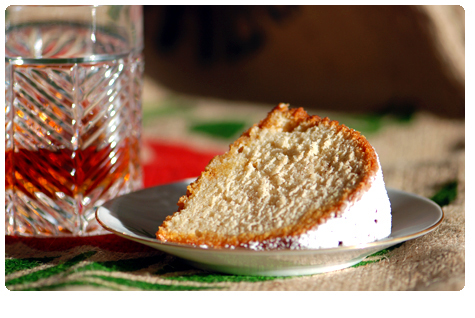I found a recipe for a “Key lime meringue tart” in a recent issue of Bon Appétit. The photo was gorgeous and the title sounded swank and modern. I’d been craving something citrus-y and custard-y and am crushing on meringues (despite years of gagging at the very sight of them)—it was fate. But, as I stared longingly at the picture and read the title over I recognized something I knew very well—I grew up on “Key lime meringue tart,” knowing it as “pastel de limón,” which technically translates into lemon pie. No swagger or bragging…Our recipe wasn’t ahead of the curve or attempting to reinvent the classic. The fact is, there are no lemons in Nicaragua, just limes and tiny little Key limes known as “limones criollos.”
Though I remember my pastel de limón warmly, it had a few pitfalls. The crust could be soggy, the filling like unnaturally colored Jell-O pudding. If I remember correctly, the filling was more like pudding than curd—milk and cornstarch-based. The recipe I made is a Frankensteined mess of a pie crust I always use, a lime curd that borrows from the Bon Ap, recipe and a Cook’s Country lemon squares recipe. I loved it—you’ll love it. I liked it so much that I made for a dinner party and didn’t even offer my guests an extra piece to take home. Rude little pig. Tsk, tsk.
PASTEL DE LIMON
For the Crust (for an 8-inch diameter tart pan with removable bottom)
200 grams all-purpose flour (1 cup + 6 tablespoons)
3 tablespoons sugar
½ teaspoon salt
8 tablespoons cold unsalted butter, cut into small pieces
1 egg, lightly beaten
Ice water
– Combine the flour, sugar, and salt on a clean, dry work surface. With a bench scraper, cut in the butter in until it resembles wet sand. Alternatively, combine the flour and salt in the bowl of a food processor and add the butter. Pulse until the mixture resembles wet sand.
– Form a well in the center of the flour mixture and pour in the egg plus 1 tablespoon ice water. If using a food processor, add the egg and water and pulse just until the mixture comes together. If the mixture appears very dry and crumbly, add water, 1 teaspoon at a time, until the mixture is cohesive but not overly wet.
– Bring the dough together with your hands. Pinch off pieces of dough (about 2-inch pieces) and with heel of hand extend on surface. This method, called fraisage, ensures that the butter is evenly distributed in the dough. Shape the dough into a disc and wrap in plastic. Refrigerate for 30 minutes.
– On a lightly floured surface, roll the dough out to about 10 inches in diameter. Gently transfer the dough to the tart pan. Press the dough into the pan, making sure to fill the ridges. Use kitchen shears or a paring knife to trim off any excess overhang and lightly dock all over with a fork. Transfer the lined shell to refrigerator and chill 30 minutes, then, freeze for 20 minutes. Preheat the oven to 375˚F.
– Line the frozen shell with foil or parchment paper (this is not wax paper!) and fill it completely with pie weights or dry beans. Bake until the dough looks opaque, 20 to 25 minutes. Transfer to a cooling rack.
– Reduce the oven temperature to 350˚F.
For the Curd
Pulsing the sugar and the zests adds an extra—well, zest! to the custard. I won’t judge you if you opt to ignore the step, though. Prepare the curd while the tart shell bakes. Save the egg whites for the meringue.
4 large eggs
3 large egg yolks
½ cup sugar
¼ teaspoon salt
1 tablespoon lime zest
1 tablespoon lemon zest
1/3 cup lime juice
¼ cup lemon juice
4 tablespoons unsalted butter
3 tablespoons heavy cream
-Process the sugar, lime and lemon zests in a food processor until zests are thoroughly broken down.
-Whisk the eggs, egg yolks, sugar, and salt together in a medium saucepan. Add the lime and lemon zests, lime and lemon juices and cook over medium-low heat, stirring constantly, until thickened and the consistency of pudding, 8 to 10 minutes. Strain the curd into a medium bowl. Add the butter and cream and stir until completely incorporated.
-Pour the filling into the blind-baked crust and bake about 15 minutes until set. Transfer tart to a cooling rack and cool to room temperature, about 1 hour. Transfer to refrigerator and chill completely, at least 2 hours.
For the Meringue
If using a stand mixer, use the whisk attachment.
4 large egg whites, at room temperature
¼ teaspoon salt
2/3 cup sugar
¼ cup powdered sugar
1 teaspoon vanilla extract
– Place the whites and salt in a clean, dry mixing bowl. Beat the whites on medium speed with an electric mixer until they loosen. Increase the speed to medium-high and whisk until soft peaks form, 2 to 3 minutes. Slowly add the sugar and powdered sugar and continue to whisk until stiff, glossy peaks form, 2 to 3 minutes more. Add the vanilla and whisk to incorporate.
-Top the chilled tart and bake at 450˚F until golden, 6 to 8 minutes. Serve.

